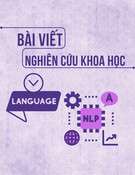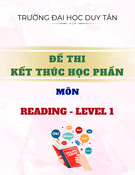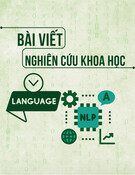
VĂN HÓA https://jst-haui.vn Tạp chí Khoa học và Công nghệ Trường Đại học Công nghiệp Hà Nội Tập 60 - Số 12 (12/2024)
90
NGÔN NG
Ữ
P
-
ISSN 1859
-
3585
E
-
ISSN 2615
-
961
9
TEACHERS AND STUDENTS' PERCEPTIONS OF USING VIDEOS WITH CAPTIONS TO IMPROVE ENGLISH SPEAKING SKILLS
NHẬN THỨC CỦA GIẢNG VIÊN VÀ SINH VIÊN VỀ VIỆC SỬ DỤNG VIDEO CÓ PHỤ ĐỀ ĐỂ CẢI THIỆN KỸ NĂNG NÓI TIẾNG ANH Nguyen Minh Ngoc1,*, Nguyen Thi Minh Huyen1, Luong Hue Phuong1 DOI: http://doi.org/10.57001/huih5804.2024.422 1. INTRODUCTION In recent years, the integration of video technology with information technology (IT) has significantly evolved, enabling educators to virtually bring authentic language environments into the classroom. This advancement allows students to access real-time or recorded news, music, and sports from around the world. Numerous scholars in applied linguistics have acknowledged the pedagogical benefits of using video in language instruction. One of the most notable advantages of video technology is its ability to immerse learners in complete communicative situations [1]. Another key benefit lies in its capacity to convey non-verbal communication cues and facilitate cross-cultural comparisons [2]. Furthermore, the use of videos in the classroom supports differentiated instruction, catering to students' diverse abilities, learning styles, and personalities. In order to better facilitate the use of videos in learning and teaching, it is important to explore the perspectives of both teachers and ABSTRACT This paper presents
the perceptions of educators and students at a public university in Vietnam
regarding the use of captioned videos for teaching and learning speaking skills. The primary objective is to
explore both the overall perceptions and the perceived benefits and ch
allenges associated with using
videos with captions in English-
speaking instruction. Employing both qualitative and quantitative
approaches, the study involved five teachers and 50 second-year English majors.
Data were gathered using
questionnaires and semi-structured interviews, and then analyzed
. The findings reveal that both teachers
and students generally hold positive views of using captioned videos in instruction. These videos contribute
to enhancing students' speaking skills, while also motivating them by linking classroom learning with
authentic language use. Additionally, teachers appreciate the creative potential that video-
based
instruction offers. D
espite the positive reception, the study also highlights certain challenges, underscoring
the need for thoughtful planning and effective implementation. Keywords: University students; teachers; video with captions; speaking skills; perceptions. TÓM TẮT Bài báo này trình bày nghiên cứu về nhận thức của giảng viên và sinh viên tại một trường đại họ
c công
lập ở Việt Nam về việc sử dụng video có phụ đề trong dạy và học kỹ năng Nói Tiếng Anh. Nghiên cứu này s
ử
dụng phương pháp định tính và định lượng với sự tham gia của 5 giảng viên và 50 sinh viên năm thứ
2,
chuyên ngành Ngôn ngữ Anh. Dữ liệu được thu thập thông qua bảng hỏi và phỏng vấn, sau đó đượ
c phân
tích. Kết quả nghiên cứu cho thấy, cả giảng viên và sinh viên đều có quan điểm tích cực về việc sử dụ
ng
video có phụ đề trong việc dạy và học kỹ năng Nói. Những video này góp phần nâng cao kỹ năng nói củ
a
sinh viên, đồng thời tạo động lực cho sinh viên bằng việc tạo ra được sự kết nối giữa việc học trên lớp vớ
i
việc sử dụng ngôn ngữ thực tế. Ngoài ra, các giảng viên đánh giá cao tiềm năng sáng tạ
o mà các video mang
lại cho sinh viên. Nghiên cứu cũng nêu ra một số thách thức, từ đó giúp giảng viên có thể hiểu rõ và triể
n
khai hiệu quả hơn phương pháp này. Từ khoá: Sinh viên đại học; giảng viên; video có phụ đề; kỹ năng Nói; nhận thức. 1School of Languages and Tourism, Hanoi University of Industry, Vietnam *Email: nguyenminhngoc@dhcnhn.edu.vn Received: 08/9/2024 Revised: 27/10/2024 Accepted: 26/12/2024

P-ISSN 1859-3585 E-ISSN 2615-9619 https://jst-haui.vn LANGUAGE - CULTURE Vol. 60 - No. 12 (Dec 2024) HaUI Journal of Science and Technology
91
students, as their practical experience provides crucial insights into effective teaching methodologies. Accordingly, this study seeks to explore the perceptions of educators and learners regarding the use of videos with captions in language instruction, particularly in improving English speaking skills. To this end, the research aims to answer two primary questions: What are students’ perceptions of using videos with captions to teach speaking skills? What are teachers' perceptions of using videos with captions in English-speaking lessons? 2. LITERATURE REVIEW 2.1. Speaking skills Mulgrave [3] emphasizes that speaking serves as a tool for conveying messages directly to the listener. Brown [4] describes speaking as the process of constructing and sharing meaning through both verbal and non-verbal symbols across various contexts. Similarly, Harmer [5] defines speaking as an interactive process involving the production, reception, and processing of information to construct meaning. In terms of speaking proficiency, several key aspects must be addressed by learners. Brown [4] identifies five critical components of speaking skills including fluency, comprehension, grammar, vocabulary, and pronunciation. 2.2. Videos with caption Richards and Renandya [6] describe video as a highly dense medium that integrates a wide range of visual elements and diverse audio experiences, in addition to spoken language. According to Harmer [5], video is beneficial for language learning since it enables students to observe language in use, enhancing comprehension by conveying general meanings and emotions through expressions, gestures, and other visual cues. Additionally, video serves as a valuable tool for fostering cross-cultural understanding. Captions are defined as on-screen text in the same language as the accompanying soundtrack, displayed synchronously with the video [7]. Sydorenko [8] identifies different types of on-screen text, including subtitles (L1 text, L2 sound), reversed subtitles (L1 sound, L2 text), and captions (where the text and sound are in the same language). This study focuses on captions that pair L2 sounds with L2 text, both in English. Moreover, it is important to highlight the dimensions of the video with captions including the video length, speaking speed, and the video’s elements such as sound effects and music, characters, location, costumes, and dialogue [9]. Since language learners often struggle to decode the speech of native speakers, video captioning provides an effective tool to aid comprehension by helping learners connect written words with their spoken forms. 2.3. Videos with captions in language learning and teaching It is a fact that learners who engage with captioned videos demonstrate improved pronunciation and fluency, as they are able to imitate the authentic speech patterns and intonations presented [9]. Captions also aid language production by providing clarity in sentence structures and vocabulary, which are crucial for effective communication. This is particularly beneficial for English as a Second Language (ESL) learners, who may have limited opportunities to practice speaking with native speakers. Hence, the inclusion of captions in video-based instruction further enhances its educational value [10]. Additionally, Huang and Eskey [9] emphasize that captioned videos create a dynamic and engaging learning environment by exposing students to authentic language use in diverse contexts, which is often difficult to achieve through traditional teaching methods. Videos offer rich input, including not only spoken language but also non-verbal elements such as gestures and facial expressions, which are essential for understanding meaning in real-life communicative situations. This exposure is particularly advantageous for developing speaking skills, as learners can observe and emulate real-world language use. Research by Lee and Kwon [11] supports this view, noting that most students show heightened interest when they can both see and hear the language in use, especially when combined with communicative tasks. Although videos offer significant benefits to language learners, they are not without limitations. One challenge teachers face is finding videos that align with their students’ specific needs, as certain types of videos, such as commercial ones, are limited in availability [11]. Teachers also struggle with selecting appropriate films and dealing with the time-consuming preparation required for video-based lessons. Furthermore, students often have limited opportunities for interaction with peers and teachers during video-based activities. Some students may focus more on the plot than on the language itself, preferring to watch rather than listen [10]. Additionally, if the video’s plot is too lengthy or complex, students may become fatigued and struggle to grasp the

VĂN HÓA https://jst-haui.vn Tạp chí Khoa học và Công nghệ Trường Đại học Công nghiệp Hà Nội Tập 60 - Số 12 (12/2024)
92
NGÔN NG
Ữ
P
-
ISSN 1859
-
3585
E
-
ISSN 2615
-
961
9
language [12]. These factors indicate that both student engagement and teaching strategies play a crucial role in determining the effectiveness of video use in language classrooms. 3. METHODOLOGY 3.1. Setting and participants The research was conducted during the first semester of the 2023 - 2024 academic year at a university in Hanoi. The participants included 50 second-year English majors who are in B1 level and five experienced English language teachers specializing in teaching speaking skills. All the participating teachers held a master’s degree in English Language Teaching Methodology and had substantial teaching experience, ranging from six to twelve years, reflecting their strong professional expertise in the field. During speaking lessons, videos with captions are flexibly integrated into the activities of the lesson with the aim of eliciting or providing background knowledge, or as an activity for students to generate ideas. 3.2. Data collection A mixed-method approach was used, incorporating both questionnaires and in-depth interviews to collect data. The questionnaire featured 5 multiple-choice questions, 1 five-point Likert scale question with responses ranging from "1. strongly disagree" to "5. strongly agree" and 1 open-ended question. Students were requested to specify their level of agreement with the given statements. Additionally, five English teachers took part in in-depth interviews, which were recorded and subsequently transcribed for analysis. The interviews, lasting approximately ten minutes each, consisted of five open-ended questions designed to elicit detailed responses from the teachers. During the research, the respondents were given pseudonyms as T1A, T2B, T3C, T4B, and T5D to ensure their privacy. The questionnaire and interview questions were adapted from Huang and Eskey [9] and Lee and Kwon [11]. Moreover, they also underwent a piloting process to further ensure the reliability and validity. 3.3. Data analysis The questionnaire data from both teachers and students were input into Excel to calculate item frequencies aligned with specific research targets. For the interview data, a structured process was followed, involving transcription, categorization, and interpretation. The transcribed interviews were organized based on the research questions and then compared to identify key insights. Ultimately, the data from the questionnaires and interviews were combined and analyzed together, allowing for a comprehensive interpretation of the research findings. 4. RESULTS AND DISCUSSION 4.1. The students’ perceptions of the use of videos with captions for improving speaking skills 4.1.1. Students’ perceptions of the relevance of vocabulary used in videos with captions Figure 1. Students’ perceptions of the relevance of using vocabulary in videos with captions The chart indicates that 64% of the students found the vocabulary in videos with captions challenging but engaging. A smaller portion, 20%, considered the vocabulary difficult, while 16% thought that it was normal. Significantly, none of the students found the vocabulary easy. This suggests that the teacher selected videos with an appropriate difficulty level in terms of vocabulary, effectively aiding in the improvement of students' speaking skills. 4.1.2. Students’ perceptions of the relevance of speaking speed in videos with captions Figure 2. Students’ evaluation of speaking speed

P-ISSN 1859-3585 E-ISSN 2615-9619 https://jst-haui.vn LANGUAGE - CULTURE Vol. 60 - No. 12 (Dec 2024) HaUI Journal of Science and Technology
93
Based on the chart, 84% of the students found the speaking speed of videos with captions to be at a normal speed. A smaller group, accounting for 10%, felt the speed was rather fast while a mere 6% believed the speaking speed was fast. It can be inferred that the video materials used in this study were well-suited for enhancing students' learning, particularly in relation to the speed, which did not overwhelm most learners. 4.1.3. Students’ perceptions of the relevance of the length of videos with captions Figure 3. Students’ evaluation of the length of videos The pie chart illustrates that 84% of the students felt that the video lengths were reasonable. A smaller group, 12%, mentioned that the videos were somewhat long, while a minority of 4% expressed dissatisfaction, feeling that the videos were short. This indicates that the researcher was successful in selecting videos of appropriate lengths that met the majority of students' preferences and learning needs. 4.1.4. The students’ perceptions of the elements in videos with captions Figure 4. Students’ perceptions of their favorite elements in the videos For the students' preference for video elements, Characters and Locations emerged as the top two elements that caught students' attention the most, with 82% and 78% of students selecting them, respectively. On the other hand, Sound effects and Music were found to be the least appealing, with only 18% of students responding positively to those aspects. This suggests that students are more engaged by visual and narrative elements (such as characters and locations) than by auditory elements when it comes to classroom videos. 4.1.5. Aspects of students’ speaking skills have been improved Figure 5. The aspects of speaking skills have been improved by the students The data in Figure 5 shows most of the students (90%) admitted that they have made much progress in their English speaking skills thanks to the lessons using videos with captions. All criteria of English speaking skills including fluency, vocabulary, grammar, pronunciation, and comprehension met their expectations. 4.1.6. Purposes of using videos with captions and their effectiveness from the students’ viewpoints Table 1 reveals different purposes of using videos with captions and their effectiveness from the students’ viewpoints. Table 1. Effectiveness of using videos with captions Strongly agree (%) Agree (%) Neutral (%) Disagree (%) Strongly disagree (%) encourage students to talk 32 52 10 6 0 make the lessons lively and interesting 10 90 0 0 0 provide students with real communicative environment 0 90 10 0 0 draw students’ attention 32 64 4 0 0

VĂN HÓA https://jst-haui.vn Tạp chí Khoa học và Công nghệ Trường Đại học Công nghiệp Hà Nội Tập 60 - Số 12 (12/2024)
94
NGÔN NG
Ữ
P
-
ISSN 1859
-
3585
E
-
ISSN 2615
-
961
9
The data collected from the students' survey questionnaire reveals that all of the teacher's purposes listed were highly evaluated by the students, with strong agreement percentages significantly surpassing others. 84% of students reported that their teachers utilized videos with captions to motivate them to express their thoughts. Furthermore, 100% of the students acknowledged that the teacher's intention behind using videos with captions was to create lively and engaging lessons. Additionally, 90% of students supported the idea that providing a real communicative environment was a key aim of using these videos. Lastly, 96% of the students indicated that drawing attention was one of the teachers' objectives when incorporating videos with captions into speaking lessons. In summary, the data indicates that students have diverse and positive opinions regarding the use of videos with captions in their speaking lessons. 4.1.7. Things that students do not like about learning to speak English with the videos with captions An open question was designed to identify the disadvantages of learning to speak English using videos with captions. Students were asked to list two aspects they disliked about these videos. From their responses, three main factors emerged that hindered their concentration on learning spoken language. First, the vivid images and appealing music in some videos often distracted students from the main task. Many students found themselves engrossed in the visuals or melodies, which led them to overlook the language usage or key events that needed to be memorized for later discussion. Consequently, some students missed opportunities to practice speaking. One student wrote, “Sometimes I can’t answer the questions my teacher asked because I did not follow the content of the video.” Second, several students expressed frustration with the speed at which speakers in some videos talked, making it difficult for them to keep up with the captions. For instance, a student shared their experience with a clip about the Mid-Autumn Festival: “I think the speed is too fast for me. I hate it. I have to guess a lot because the character’s speaking is not easy to understand, even with captions. She spoke rather fast.” Third, some students felt that certain videos were too short to meet their learning needs. As one student stated, “I think the videos are interesting but what I hate is that it’s too short. I want to watch more. I would like to see longer clips. If we grasp more actions happening in the scene, we will have more opportunities to discuss.” Overall, students generally hold a positive view regarding the use of captioned videos for teaching speaking skills. They believe incorporating these videos in language lessons has significantly improved their English speaking skills, including fluency, vocabulary, grammar, pronunciation, and comprehension. This positive impact is supported by research from Huang and Eskey [9] and Perez et al. [10], which emphasizes how captioned videos enhance pronunciation, fluency, and language production by clarifying sentence structures and vocabulary. Furthermore, these videos encourage dialogue, active engagement, the creation of an authentic communicative atmosphere, and sustained focus during instructional sessions. Nonetheless, students have also pointed out challenges associated with this approach, including distractions from vivid visuals, background music, and rapid speech in videos, as well as the mismatch between certain video content and diverse learning needs. This finding is consistent with the findings of Lee and Kwon [11], highlighting the difficulty in locating videos customized to individual student needs. Moreover, these challenges echo the concerns raised by Wang [12] regarding intricate or lengthy video plots, which may lead to student fatigue and impede language comprehension. 4.2. Problems faced by teachers when using videos with captions in English-speaking lessons 4.2.1. Time management The first problem teachers faced was time management. Creating and editing videos was time-consuming, as it required significant effort to format them for classroom use. Finding suitable videos online was also a daunting task. Although platforms like YouTube offer numerous options, locating high-quality, engaging content that matched lesson objectives often took hours. Additionally, setting up projectors and ensuring the right videos were ready for class further added to the time constraints. 4.2.2. Students’ overuse of native language The second problem teachers faced was students' tendency to use their native language instead of English during classroom tasks. They often resorted to their native language to communicate important ideas, fearing they would lose face in front of peers if they struggled to express themselves in English. For instance, when asked












![Đề cương môn Tiếng Anh 1 [Chuẩn Nhất/Mới Nhất]](https://cdn.tailieu.vn/images/document/thumbnail/2025/20251130/cubabep141@gmail.com/135x160/51711764555685.jpg)










![Mẫu thư Tiếng Anh: Tài liệu [Mô tả chi tiết hơn về loại tài liệu hoặc mục đích sử dụng]](https://cdn.tailieu.vn/images/document/thumbnail/2025/20250814/vinhsannguyenphuc@gmail.com/135x160/71321755225259.jpg)


